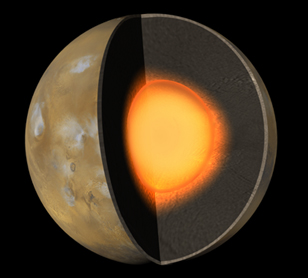
Geotimes Home | AGI Home | Information Services | Geoscience Education | Public Policy | Programs | Publications | Careers

 The more researchers
study Mars, the more similarities they seem to find between the Red Planet and
Earth. The latest parallels come from the planet’s enigmatic interior. As
is the case with Earth’s, the martian core appears to be about half the size
of the planet and, to some extent, liquid iron, according to new research out
of NASA.
The more researchers
study Mars, the more similarities they seem to find between the Red Planet and
Earth. The latest parallels come from the planet’s enigmatic interior. As
is the case with Earth’s, the martian core appears to be about half the size
of the planet and, to some extent, liquid iron, according to new research out
of NASA. |
Geotimes Home | AGI Home | Information Services | Geoscience Education | Public Policy | Programs | Publications | Careers |